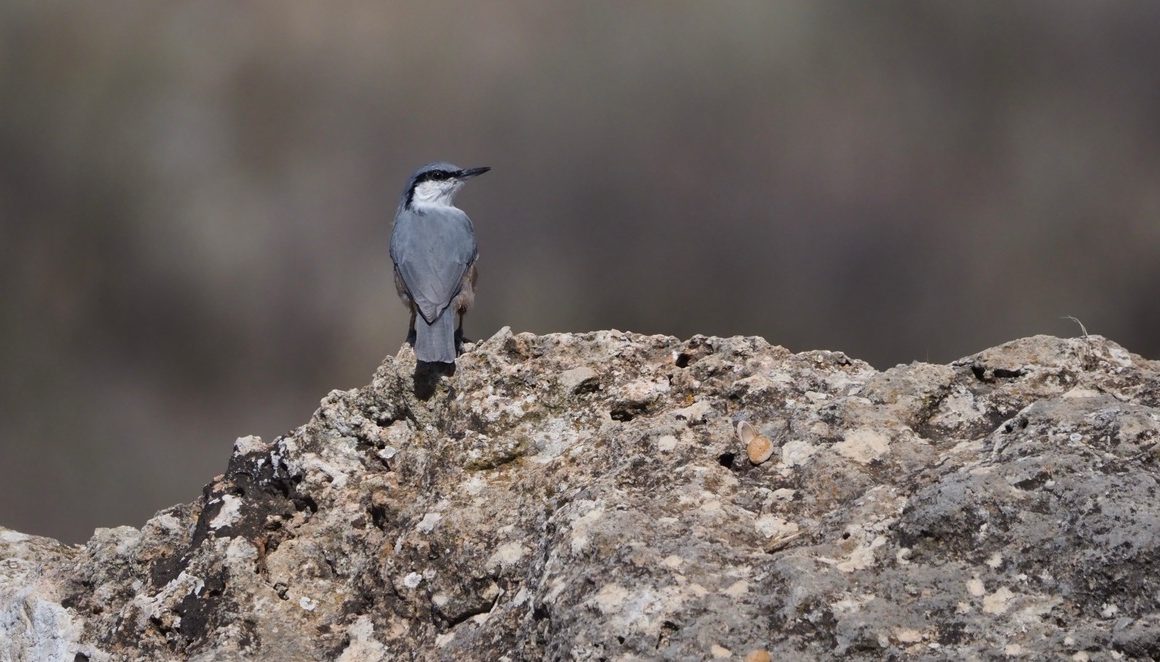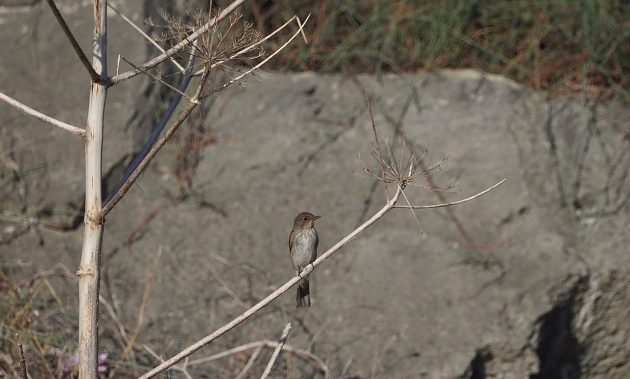
You know things are getting desperate when you get excited by an unexpected flock of Starlings. Here I was, six days into a trip to Mani, in the Greek Peloponnese, and my bird list had yet to reach 40 species. It was early in the morning, and I was trudging up a dried-up river valley in the hope of finding a few birds. I’d already seen a solitary Chiffchaff, a Spotted Flycatcher and a Grey Wagtail, so by my modest standards I wasn’t doing too badly. Then, suddenly, the little flock of seven Starlings flew over, my 39th species, and one I wasn’t expecting.

A cock Cirl Bunting, a common resident in the Peloponnese, south-west Greece
This was really quite exciting. I continued my walk, noting a cock Cirl Bunting, few Blackbirds, a Robin (no doubt a migrant from the north), several Blackcaps and a Sardinian Warbler, plus a couple of feral cats. The river bed looked as if hadn’t seen a drop water for at least eight months. It doesn’t rain much in this part of Greece. I turned round and headed back to the coast, where a couple of German motorhomes had parked under the tamarisks for the night, saving themselves a camp-site fee.

A migrant Spotted Flycatcher, heading south
Before leaving I made a quick check of the shore. The sea beyond – the Gulf of Messina – was already a wonderful shade of deep Mediterranean blue, though the sun had hardly risen. It’s not a great coast for seabirds: in the previous days I’d seen a single Shag and half a dozen Yellow-legged Gulls, and on this occasion there wasn’t even a gull to be seen. But out of the corner of my eye I noted a darting movement, and suddenly there was a splendid little Kingfisher, sitting on a rock. (In Europe we have just the single species of kingfisher: eBird calls it the Common Kingfisher). The light was poor, as the sun had yet to clear the mountains, but I reached for my camera even so. The bird stayed just long enough for me to grab half a dozen shots, which proved to be surprisingly satisfactory, if not quite in the Kai Pflug league. They were, in fact, much the best bird photographs I’d taken all week. I had found Peloponnese birds to be not only elusive, but shy, and despite lugging my camera and long lens around, had hardly pointed it at a single bird.

Kingfishers are always good to see
One bird I had photographed, albeit not very satisfactorily, was also one of the most interesting species I’d found, a Western Rock Nuthatch. As the name suggests, these nuthatches prefer rocks to trees, and there’s no shortage of rocks in this part of Greece. They are a Balkan special, their range extending along the Adriatic coast, then round the Mediterranean/Aegean coast of Greece (and a fair way inland), and on to Turkey. I’ve seen them as far east as Georgia, where you can also find the very similar Eastern Rock Nuthatch. (I’ve seen them there, but they are a tricky duo to tell apart). Both species have one thing in common, for they are very noisy throughout the year. I found my pair of Rock Nuthatches on a sea cliff between the villages of Agios Nickolaos and Trahila, alerted to their presence by their noisy whistling. However, try as I did I, couldn’t see them.

Rock Nuthatches are noisy birds throughout the year

A prickly pear provides a perch for this Rock Nuthatch
I went back the next morning, and this time I found them easily. Nuthatches are such active little birds that they are always entertaining to watch. It is, I suspect, unusual to see a single Rock Nuthatch, for they are social birds that remain in pairs all year round. I’ve seen them a number of times – my first sighting was of a pair at Delphi, one of the most celebrated ancient sites in Greece, over 40 years ago – but they can be elusive, and it’s not uncommon to visit a favoured site and miss them entirely. They weren’t a year-bird for me, as I had already seen a pair at Sidirocastro in northern Greece back in May.

At last – a Nuthatch in the sun
The nuthatches shared their cliff with several pairs of Blue Rock Thrushes. The behaviour of these handsome thrushes contrasts with that of the nuthatches, for they like to sit for long periods, surveying their territory from a prominent perch. I rather like the Spanish name for them – roquero solitario. Though I have come across approachable individuals in Spain, in Greece they are typically shy, swooping away when you get too close. I was interested to note what appeared to be courting behaviour, not something I could find mention of in the literature, where I read that the pair bond breaks down outside the breeding season, and the birds then lead a solitary life. What were these birds displaying for in late September? They clearly hadn’t read the same books as me.

Blue Rock Thrush – always shy and wary
To be concluded.













In one post you make me both want to go to Greece (rock nuthatch!!) and doubt the wisdom (40 birds only??). I can’t wait until next week’s conclusion…
I saw my first Rock Nuthatches in Turkey a couple of years ago. I couldn’t believe there was such a creature. It was like meeting a Mountain Flamingo, or a Polar Trogon.